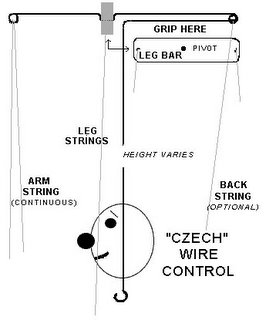
WIRE MARIONETTE CONTROLS
May 2002
Traditional European marionette controls may date back to the ancient Greeks. The simplest translation of the words describing how puppets can be controlled is "metal wires." The more complicated string controls probably came in during the Renaissance when Marco Polo et al. re-established trade with the Orient and Chinese string puppets were brought back. These gave rise to the fantocinni figures which eclipsed their older cousins, except for the armored knights of the Sicilian tradition and miniature figures now most prevalent as toys, generally referred to as "Czech" marionettes. Such puppets have been manufactured for at least 100 years, including some produced in New York in the '30s by Mme. Alexander, designed by Tony Sarg. Today they are occasionally used professionally, often for table top shows. This method of control deserves closer scrutiny.
The general form is a single long wire which passes through the head of the figure out the neck, ending in a narrow loop which hooks into staple or similar connector at the top of the body. The top of the wire is bent forward at a right angle to form an inverted "L". That end is curled into a eyelet for the continuous hand-string. The leg bar, either wire or wood, pivots on this short section. It's not normally removable. Strings from either end go down to the knees, often through the skirt, robe, or tunic of the puppet, By rocking the bar while moving the puppet, a satisfactory walk can be achieved.
To make the control easier to hold, the wire may first be bent back then forward to make the top bar, forming a short narrow loop to the rear, which may then be curved downward slightly. The pivot point may be defined by bending a small niche into the top bar which keeps the leg bar in position. A hanging loop can be tied to top bar behind the leg bar, which incidently, is usually only slightly wider than the hips of the puppet.
The bodies of commercial "Czech" marionettes are often simple blocks of wood with no flexibility at the waist. This would interfere with the "walk." The upper arm is often merely wire with a loop at either end. The lower arm are cast from plaster or sawdust and glue with a loop at the elbow. Dancers may have thighs made the same way, but a firmer "walk" is achieved using wood with a staple at the hip end which fits into a slot sawn in the body and pivots on a small nail. The knee end has a similar slit, which accepts a staple cast into the calf and foot. Such legs move in a very determined fashion.
Traditional string puppet bodies can be adapted to use such controls. The waist may have to be stiffened , while leg and hip joints may need to be restricted to achieve believable movement. The hardest thing for such puppets to do is bow. Lying down with the head back requires a joint in the main rod at the top of the head similar to those at the hip. The range of simple and direct movements these figures can achieve makes them quite usable for dramatic productions. Less experienced puppeteers can achieve effective performances more quickly, and since one operator can walk a puppet on and present simple gestures, fewer puppeteers may be required to present a scene than when using western "bunraku-inspired" figures.
Email: Will Stackman, Master of Motions
posted by will 12:23 PM